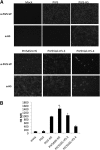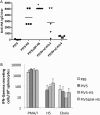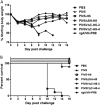Efficacy of parainfluenza virus 5 mutants expressing hemagglutinin from H5N1 influenza A virus in mice
- PMID: 23804633
- PMCID: PMC3754099
- DOI: 10.1128/JVI.01289-13
Efficacy of parainfluenza virus 5 mutants expressing hemagglutinin from H5N1 influenza A virus in mice
Abstract
Parainfluenza virus 5 (PIV5) is a promising viral vector for vaccine development. PIV5 is safe, stable, efficacious, cost-effective to produce and, most interestingly, it overcomes preexisting antivector immunity. We have recently reported that PIV5 expressing the hemagglutinin (HA) from highly pathogenic avian influenza (HPAI) virus H5N1 (PIV5-H5) provides sterilizing immunity against lethal doses of HPAI H5N1 infection in mice. It is thought that induction of apoptosis can lead to enhanced antigen presentation. Previously, we have shown that deleting the SH gene and the conserved C terminus of the V gene in PIV5 results in mutant viruses (PIV5ΔSH and PIV5VΔC) that enhance induction of apoptosis. In this study, we inserted the HA gene of H5N1 into PIV5ΔSH (PIV5ΔSH-H5) or PIV5VΔC (PIV5VΔC-H5) and compared their efficacies as vaccine candidates to PIV5-H5. We have found that PIV5ΔSH-H5 induced the highest levels of anti-HA antibodies, the strongest T cell responses, and the best protection against an H5N1 lethal challenge in mice. These results suggest that PIV5ΔSH is a better vaccine vector than wild-type PIV5.
Figures






Similar articles
-
Recombinant parainfluenza virus 5 expressing hemagglutinin of influenza A virus H5N1 protected mice against lethal highly pathogenic avian influenza virus H5N1 challenge.J Virol. 2013 Jan;87(1):354-62. doi: 10.1128/JVI.02321-12. Epub 2012 Oct 17. J Virol. 2013. PMID: 23077314 Free PMC article.
-
Recombinant parainfluenza virus 5 expressing clade 2.3.4.4b H5 hemagglutinin protein confers broad protection against H5Ny influenza viruses.J Virol. 2024 Mar 19;98(3):e0112923. doi: 10.1128/jvi.01129-23. Epub 2024 Feb 2. J Virol. 2024. PMID: 38305155 Free PMC article.
-
Recombinant parainfluenza virus 5 vaccine encoding the influenza virus hemagglutinin protects against H5N1 highly pathogenic avian influenza virus infection following intranasal or intramuscular vaccination of BALB/c mice.J Virol. 2013 Jan;87(1):363-71. doi: 10.1128/JVI.02330-12. Epub 2012 Oct 17. J Virol. 2013. PMID: 23077318 Free PMC article.
-
Single-dose vaccination of a recombinant parainfluenza virus 5 expressing NP from H5N1 virus provides broad immunity against influenza A viruses.J Virol. 2013 May;87(10):5985-93. doi: 10.1128/JVI.00120-13. Epub 2013 Mar 20. J Virol. 2013. PMID: 23514880 Free PMC article.
-
Parainfluenza virus 5 is a next-generation vaccine vector for human infectious pathogens.J Med Virol. 2023 Mar;95(3):e28622. doi: 10.1002/jmv.28622. J Med Virol. 2023. PMID: 36846910 Review.
Cited by
-
Protective Efficacy of the Conserved NP, PB1, and M1 Proteins as Immunogens in DNA- and Vaccinia Virus-Based Universal Influenza A Virus Vaccines in Mice.Clin Vaccine Immunol. 2015 Jun;22(6):618-30. doi: 10.1128/CVI.00091-15. Epub 2015 Apr 1. Clin Vaccine Immunol. 2015. PMID: 25834017 Free PMC article.
-
Intranasal vaccine for Lyme disease provides protection against tick transmitted Borrelia burgdorferi beyond one year.NPJ Vaccines. 2024 Feb 15;9(1):33. doi: 10.1038/s41541-023-00802-y. NPJ Vaccines. 2024. PMID: 38360853 Free PMC article.
-
A chimeric influenza hemagglutinin delivered by parainfluenza virus 5 vector induces broadly protective immunity against genetically divergent influenza a H1 viruses in swine.Vet Microbiol. 2020 Nov;250:108859. doi: 10.1016/j.vetmic.2020.108859. Epub 2020 Sep 18. Vet Microbiol. 2020. PMID: 33039727 Free PMC article.
-
Immunogenicity of novel mumps vaccine candidates generated by genetic modification.J Virol. 2014 Mar;88(5):2600-10. doi: 10.1128/JVI.02778-13. Epub 2013 Dec 18. J Virol. 2014. PMID: 24352450 Free PMC article.
-
Complementary Mutations in the N and L Proteins for Restoration of Viral RNA Synthesis.J Virol. 2018 Oct 29;92(22):e01417-18. doi: 10.1128/JVI.01417-18. Print 2018 Nov 15. J Virol. 2018. PMID: 30135126 Free PMC article.
References
-
- Lamb RA, Kolakofsky D. 2001. Paramyxoviridae: the viruses and their replication, p 1487–1531 In Knipe DM, Howley PM. (ed), Fields virology, 4th ed. Lippincott/The Williams & Wilkins Co, Philadelphia, PA
-
- Azetaka M, Konishi S. 1988. Kennel cough complex: confirmation and analysis of the outbreak in Japan. Nippon Juigaku Zasshi 50:851–858 - PubMed
-
- Binn LN, Eddy GA, Lazar EC, Helms J, Murnane T. 1967. Viruses recovered from laboratory dogs with respiratory disease. Proc. Soc. Exp. Biol. Med. 126:140–145 - PubMed
-
- Cornwell HJ, McCandlish IA, Thompson H, Laird HM, Wright NG. 1976. Isolation of parainfluenza virus SV5 from dogs with respiratory disease. Vet. Rec. 98:301–302 - PubMed
-
- McCandlish IA, Thompson H, Cornwell HJ, Wright NG. 1978. A study of dogs with kennel cough. Vet. Rec. 102:293–301 - PubMed
Publication types
MeSH terms
Substances
Grants and funding
LinkOut - more resources
Full Text Sources
Other Literature Sources
Medical

